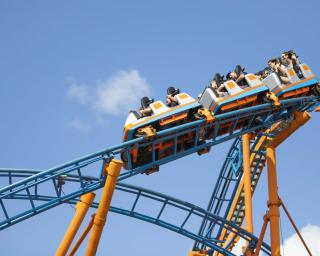Overview
The New York State Department of Labor enforces amusement ride safety throughout the state, except in New York City. Labor Department employees inspect all rides at stationary amusement parks at least once a year, and rides at traveling fairs or carnivals are inspected every time the ride is set up in a new location. A ride cannot be operated without a permit from the Department of Labor. For details please see New York State Department of Labor's Code Rule 45.
The NYS Department of Labor (DOL) inspects rides at every amusement park and traveling show located outside of New York City. To report any concerns, please email: [email protected].
All amusement rides that pass inspection and are safe to ride will have a DOL inspection tag that is visible at the ride’s point of entry. If you do not see the tag, please ask the operator to show it to you.
PLEASE NOTE: The ride safety database is currently experiencing some technical difficulties. As we work to resolve the issue, please be reminded that the best way to get the most up-to-date information on a ride is by viewing its tag. For additional information on specific rides or events, contact the Department of Safety and Health at [email protected].
More information about amusement park safety, and statistics about ride safety records and injuries, can be found on the web site of the International Association of Amusement Parks and Attractions at the International Association of Amusement Parks and Attractions (IAAPA).
What We Inspect
Parent Safety Tips
- Remember - you're the one who knows your child best, the ride operator doesn't. While your child may be tall enough to ride an amusement ride, it still may not be appropriate for him or her. Some children are afraid of heights, some are afraid of the dark and others have trouble staying seated. The ride attendant does not know your child – you do. Please carefully watch what the ride does before allowing your child to participate.
- Watch before you ride. Before you put your child on a ride, watch it first. That way, your child will know what to expect. It’s also a good idea to read the warning sign aloud with your child, and to point out the ride operator and the exit and entrance locations.
- Obey minimum height, age, weight and health restrictions.
- Don’t put children on rides they’re afraid of. Make sure your child knows not to try to get off the ride, even if he or she becomes afraid. If your child gets scared, ask if the ride can be stopped.
- Keep small children away from open sides. Always seat them on the inside
- Always use the ride’s safety equipment – seatbelts, lap bars, etc. – but be aware of their limitations. A lap bar, for instance, may still leave room for a small child to slide around, and would not be safe.
- Tell your children to keep their heads, hands, feet and arms inside the ride.
- Tell your children to not try to get off the ride until it comes to a complete stop.
- Don’t assume a ride is safe for children if you hold on to them. If you hold on to your child, you can’t look after yourself, and you may put both of you at risk.
- Teach children what to do if they become separated from you. Point out uniformed park employees who can help them, and designate a conspicuous spot as a meeting place.
- Remember that rides and water parks are fun, but they pose hazards. Rides and water park attractions are designed by manufacturers in order to make a profit. Even in the most well-known amusement parks, your children need your protection.
Children Safety Tips
- Obey the listed age, height, weight, and health restrictions.
- Observe all posted ride safety rules.
- Watch the ride first, so you know what to expect. Look and see where riders are loaded and unloaded.
- Dress for safety - secure loose clothing, jewelry and long hair. Wear closed-toed shoes or sneakers.
- Keep your head, hands, arms, legs and feet inside the ride at all times. Don't reach toward fences or barriers.
- Remain seated in the ride, in the "locked and loaded" position, until it comes to a complete stop and you are instructed to exit.
- Follow all verbal instructions given by ride operators or provided by recorded announcements.
- Keep your eyes looking forward to protect your neck from injury during sudden accelerations and changes in direction.
- Always use the safety equipment that's provided (belts, lap bars, shoulder harnesses, etc.), and check to make sure it's properly latched.
- Never attempt to wriggle free of restraints or other safety devices.
- Never stand up in a roller coaster, or rock a vehicle that's not designed to be controlled by you.
- If the ride stops temporarily, stay seated and wait for it to start up again or for an operator to give you instructions. Don't stand up or attempt to get off the ride.
- Take frequent breaks if you're riding high-g rides, such as roller coasters. Repeated high-g rides can result in the loss of consciousness, which can lead to serious injury.
- Stop riding before you get excessively tired.
- Drink plenty of fluids to avoid dehydration, but don't drink alcohol and ride. You put yourself and others at risk.
- Avoid horseplay. It's dangerous.
- Don't get on a ride that looks like it's poorly maintained or if it seems like the operator isn't paying attention.
- If you see any unsafe behavior or condition on a ride, report it to a supervisor or manager immediately.

